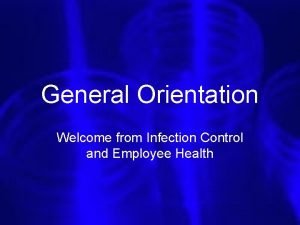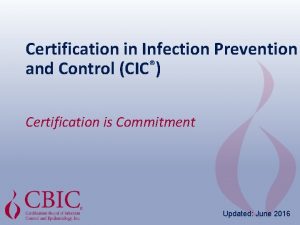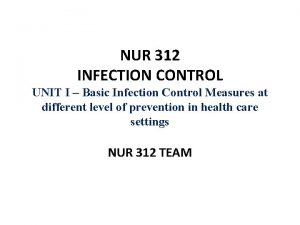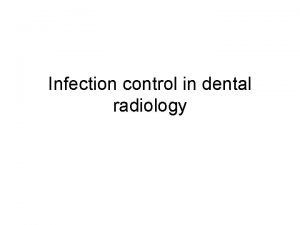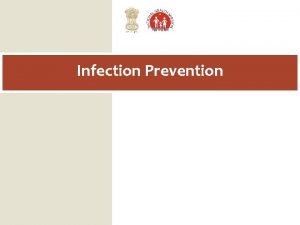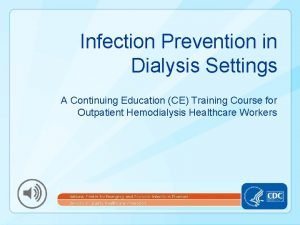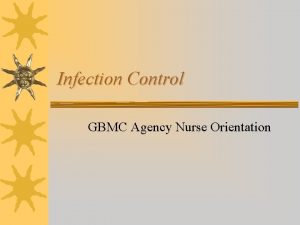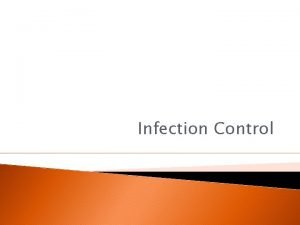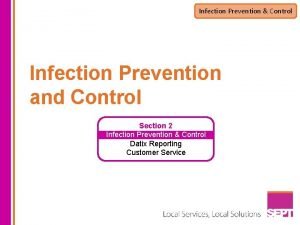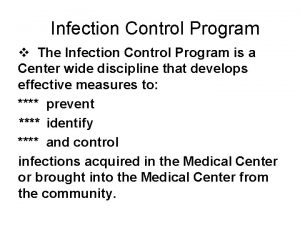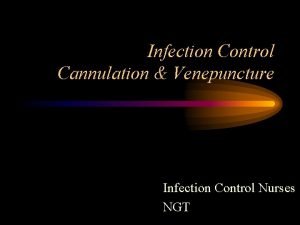Torrance Memorial Medical Center Student Orientation Infection Control

















- Slides: 17

Torrance Memorial Medical Center Student Orientation Infection Control

Infection Control Principles • Hand Hygiene (Policy IC. E. 05) • Hand hygiene is to be performed: • • • Upon entry and exit from patient room or space “Foam in – Foam out” Between patients Immediately before and after glove use Before invasive procedures: ex) Inserting a Foley, an IV, suctioning Before touching any equipment at the bedside After contact with bodily fluids • Indications for hand washing with soap and water: • If hands are visibly soiled or contaminated with blood or other body fluids • Before eating and after using a restroom • If exposed to potential anthrax or Enterovirus – D 68 • Indications for hand sanitizer: • If hands are not visibly soiled

Infection Control Principles • Standard Precautions • Treat all blood and body fluids as potentially infectious (Policy IC. E. 02) • Cleaning of reusable equipment • Clean equipment between patient use • Examples: glucose meters, blood pressure cuffs, IV pumps and poles, vital sign machines, computer keyboards, stethoscopes Wet contact time: 5 Minutes (let dry/stay on surface for 5 minutes!)

Infection Control Principles • Medical Waste • Medical waste is not based on patient’s diagnosis • What goes into a red bag? • Recognizable fluid blood • Containers with fluid blood (ex. suction canisters) • Dressing saturated with blood • What does not go into a red bag? • Gloves with dried blood • Sanitary napkins • Empty urine containers • How do I transport (to soiled utility room) red bag waste generated at bedside? • In a rigid container with lid labeled “biohazard” • Pharmaceutical Waste • See reference guide on how/where to dispose each type of pharmaceutical waste • Available inside each medication room

OSHA Guidelines • Safe Work Practices • Proper use of sharps containers • No eating or drinking in patient care areas • Use of personal protective equipment (PPE) • Gloves (wash hands before and after glove use) • Gown • Mask/face shield/eyewear • Exposure Control Plan (Policy IC. E. 21) • Blood/Body fluid, aerosol transmissible diseases, needle sticks • Post exposure • After a needle stick/exposure, always follow up with your instructor

Bloodborne Pathogens (HIV, HBV, HCV) • Transmission • Sharing needles and syringes to inject drugs • Infected pregnant woman to her baby • Sexual contact • Isolation → Standard Precautions only • Occupational Risks • Injury from needles, scalpels, broken glass • Prevention • Safe work practices • Hepatitis B vaccination

Tuberculosis (TB) • Transmission • Airborne (Coughing, Sneezing, Speaking, Singing) • Isolation → Airborne Precautions • PAPR or fit-tested to N 95 mask prior to entering room • Negative air pressure room required • Keep doors closed • Occupational Risks • Bronchoscopy • Sputum induction • Tracheostomy care

Influenza • Transmission • Respiratory secretions • Isolation →Droplet precautions (mask) • • • Protect yourself and others Get the flu vaccine in the Fall Avoid touching your eyes, nose, or mouth Cover mouth and nose with a tissue when coughing or sneezing Dispose of used tissue in the proper waste container Perform hand hygiene with alcohol gel or soap and water

Methicillin Resistant Staph Aureus (MRSA) • Transmission • Direct and indirect contact with infected or colonized patients • Isolation → Contact precautions for MRSA infected patients and r/o MRSA patients (gown, gloves, mask if suctioning) → Standard precautions for MRSA colonized patients • All MRSA patients (infected or colonized) will receive DAILY chlorhexidine gluconate (CHG) baths during their hospital stay • In the ICU, ALL patients (regardless of their MRSA status) will receive DAILY CHG baths

Clostridium Difficile (C. Diff) • Transmission • Feces. Any surface, device, or material (ex. commodes, glucose meters) that becomes contaminated with feces may serve as a reservoir for C. Diff spores. • Isolation → Contact Precautions (gown, gloves) • SPECIAL WIPES: Use SANI-CLOTH BLEACH WIPES on ALL reusable patient care equipment • Wet Contact Time: 5 Minutes • Use gloves when handling wipes • Avoid contact with eyes, skin, and clothing

Vancomycin Resistant Enterococcus (VRE) • Transmission • Feces, abdominal wounds, bandages from infected wounds. Any surface, device, or material (ex. commodes, glucose meters) that becomes contaminated with feces may serve as a reservoir • Isolation → Contact Precautions (gown, gloves)

Scabies • Transmission • Extensive skin-to-skin contact with infested person or with items such as bedding and clothing used by infested person • Isolation → Contact Precautions (gowns, gloves) for 24 hours after start of effective therapy

Patient Isolation Signs and Isolation Equipment Closets in the Lundquist Tower • Where do I look for patient isolation signs? • In plastic holders above the room number • Where do I find Personal Protective Equipment (PPE) such as gowns & masks? • Small closet next to most rooms

Patient Isolation Signs and Isolation Carts in the Central Tower • Where do I look for patient isolation signs? • Door or door frame • Where do I find PPE? • Inside yellow isolation carts

Where do I find policies? c c l i c l k i c k •

Questions? ? • Please call Infection Control Department at x 2057 if you have any questions

Quiz Click the Quiz button to edit this quiz
 Torrance memorial human resources
Torrance memorial human resources Torrance memorial cardiac rehab
Torrance memorial cardiac rehab Infection control orientation
Infection control orientation Umass memorial pharmacy
Umass memorial pharmacy Torrance creativity test examples
Torrance creativity test examples Greater baltimore medical center medical records
Greater baltimore medical center medical records Cartersville medical center medical records
Cartersville medical center medical records Dental radiology ppt
Dental radiology ppt What are universal precautions milady
What are universal precautions milady Chapter 16 infection control and standard precautions
Chapter 16 infection control and standard precautions Chapter 16 infection control and standard precautions
Chapter 16 infection control and standard precautions Chapter 15:8 using sterile techniques
Chapter 15:8 using sterile techniques Chapter 15 infection control
Chapter 15 infection control Cic infection control
Cic infection control Infection control meaning
Infection control meaning Darkroom infection control guidelines
Darkroom infection control guidelines Learning objectives for infection control
Learning objectives for infection control Infection control conclusion
Infection control conclusion


